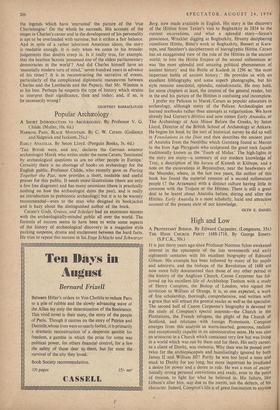Popular Archwology
A SHORT INTRODUCTION TO ARCHIEOLOGY. By Professor V. G. Childe. (Muller, 10s. 6d.) EARLY ANATOLIA. By Seton Lloyd. (Penguin Books, 3s. 6d.) 'THE British were, and are,' declares the German amateur archaeologist Marek who writes under the name Ceram, 'fascinated by archaeological questions as are no other people in Europe.' Certainly there is no shortage of books on archaeology for the English public. Professor Childe, who recently gave us Piecing Together the Past, now provides a short, readable and useful primer for this public. It needs more illustrations (there are only a few line diagrams) and has many omissions (there is practically nothing on how the archieologist dates the past), and is really an introduction to prehistoric archaeology; but it is to be warmly recommended—even to the man who designed its bookjacket and is hazy about the distinguished author of the book.
Ceram's Gods, Graves, and Scholars had an enormous success with the archwologically-minded public all over the world. The formula of success seems to have been to write some aspects of the history of archwological discovery in a magazine style packing suspense, drama and excitement between the hard facts. He tries to repeat this success in his Enge Schlacht and Schwarzer Berg, now made available in English. His story is the discovery of the Hittites from Texier's visit to Boghazkoy in 1834 to the current excavations, and what a splendid story—Sayce's prescience, Winckler digging at Boghazkoy, Hrozny deciphering cuneiform Hittite, Bittel's work at Boghazkiiy, Bossert at Kara- tepe, and Steinherr's decipherment of hieroglyphic Hittite. Ceram has an exaggerated view of the role of the Hittites in the ancient world; to him the Hittite Empire of the second millennium nc was 'the most splendid and amazing political phenomenon of ancient history' and the Battle of Kadesh in 1296 BC 'the most important battle of ancient history : ' He provides us with an excellent bibliography and some superb photographs, but his style remains anecdotal, episodic, melodramatic. He may hold, for some chapters at least, the interest of the general reader, but in the end his picture of the Hittites is confusing and incomplete.
I prefer my Pelicans to Marek /Ceram as popular educators in archaeology, although many of the Pelican Archxologies are learned textbooks rather than attempts at vulgarisation. We have already had Gurney's Hittites and now comes Early Anatolia, or The Archaeology of Asia Minor Before the Greeks, by Seton Lloyd, Director of the British School of Archmology at Ankara. He begins his book by the sort of historical survey he did so well in Foundations in the Dust and then describes the ancient past of Anatolia from the Neolithic which Garstang found at Mersin to the Iron Age Phrygians who sculptured the great rock façade traditionally known as the 'Tomb of Midas.' The high-lights in the story are many—a summary of our modern knowledge of Troy, a description of the karum of Kanesh at Ktiltepe, and a note on the excavations at Beycesultan, near the headwaters of . the Meander, where, in the last two years, the author of this book has found the material remains of a second millennium people (? the Arzawans) with a distinct culture having little in common with the Trojans or the Hittites. There is still a great deal to be learnt about Anatolia before, during and after the Hittites. Early Anatolia is a most scholarly, lucid and attractive account•of the present state of our knowledge.
GLYN E. DANIEL


























 Previous page
Previous page